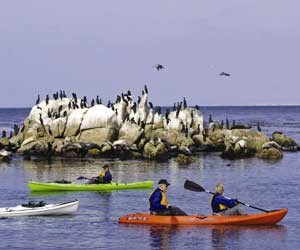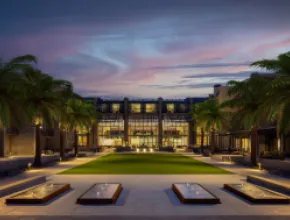Northern California’s year-round mild climate, plentiful parks and forests, easy access to both the Pacific Ocean and Sierra Nevada mountains, and support from an active population land it high on the list for planners interested in holding gatherings that incorporate the great outdoors.
It rarely snows in Northern California except in the Sierra Nevada mountains, which are well equipped to handle both snowfall and thousands of ski enthusiasts, and even around the outdoor adventure mecca of Lake Tahoe, winter temperatures tend to be mild.
In other words, snow is a lifestyle option. Some Northern Californians think nothing of swimming in San Francisco Bay on a winter morning (wearing a wetsuit, to be sure), then driving to Lake Tahoe for some afternoon skiing, and returning the next morning for a bike ride or run along the Pacific.
Outside of winter, Northern California conditions are typically dry—it usually doesn’t rain between April and October. Summer temperatures tend to drop as you head north and climb as you head east, with daytime highs for foggy San Francisco in the 60s while the highs in Sacramento, just 90 miles inland, hover in the 90s.
With a perfect setting for outdoor pursuits of every kind, Northern California’s great outdoors set the stage for invigorating agendas.
San Francisco Bay Area
Although the San Francisco Bay Area is heavily populated, its edges and interior still encompass large unpopulated areas of forest and mountains, as well as the ever-changing ocean and bay.
Groups may want to take the opportunity to sail on San Francisco Bay, where companies like San Francisco Sailing, SF Bay Adventures and OCSC Sailing can take them out on various sizes of single- or double-hull (catamaran) vessels while literally showing them the ropes of sailing.
San Francisco proper has a particularly hilly, dramatic setting, but it is possible to walk or bike along an almost entirely flat route from downtown along the Embarcadero, Marina Green and Crissy Field to the Golden Gate Bridge. It is one of the great urban American experiences, leading to the paved and unpaved trails of the Presidio, a former army base that today sees heavy traffic from rollerbladers, bicyclists and joggers.
Just offshore from Crissy Field, visitors can watch windsurfers and kite boarders sailing back and forth through the bay’s prominent winds and fog, and those with a truly adventurous side can try their hand at the sports as well.
Meanwhile, groups that want to go horseback riding can head over to the public stables at the Polo Fields in Golden Gate Park.
Just over the Golden Gate Bridge lies bucolic Marin County, where the sport of mountain biking was born on Mt. Tamalpais thanks to two-wheel tinkerers like Gary Fisher and Joe Breeze. In-shape visitors can either rent mountain bikes or bring their own and ride the Marin County hills and valleys.
Rebecca Blake, vice president of the Marin County Visitors Bureau, suggests that groups take a bus from Mill Valley to the 5,000-seat Mountain Theatre in Mt. Tamalpais State Park to see an outdoor show, then either take the bus or hike the six miles back down to Mill Valley. (Blake assures planners that people of all ages can accomplish this hike.) Meanwhile, Muir Woods, with its flat, paved paths and groves of majestic redwood trees, is a great call for groups that have mobility limitations or are simply time-limited.
On the water, visitors can kayak on relatively tranquil Richardson Bay (which separates Sausalito and Belvedere) or around Angel Island, set in the middle of San Francisco Bay near Alcatraz. On Angel Island, hiking and biking are also popular recreational pursuits, with several points around the island offering 360-degree views.
While Oakland is just as urban as San Francisco, the Oakland Museum of California conducts monthly five-mile to eight-mile bicycle tours through the historic neighborhoods around Lake Merritt, Fruitvale and West Oakland, which is filled with historic Victorian houses.
Oakland also has numerous parks, including the 4,943-acre Anthony Chabot Regional Park, which offers hiking, biking and equestrian activities and has rentable watercraft for use on its 315-acre lake.
Visitors can also rent a canoe or kayak from either California Canoe & Kayak or the Jack London Aquatic Center, and paddle around the Oakland Estuary and San Francisco Bay. The Aquatic Center has meeting space for up to 400 people for both indoor and outdoor events.
North of Oakland, Berkeley boasts several attractive parks.
Tilden Regional Park’s 2,200 acres include a beautiful golf course and various hiking trails, and there are also opportunities in the surrounding hills for bouldering and rock climbing.
Berkeley’s Aquatic Park and Cesar Chavez Park are the jewels of the urban East Bay, however. Aquatic Park’s mile-long lagoon hosts rowing, motor boating, canoeing, and even water skiing, and the park also has fitness exercise courses, a Frisbee golf course, picnic areas, and soccer fields. Cesar Chavez Park, a former landfill, is now a beautiful grassy open space and the site of Berkeley’s annual kite festival; team-building exercises in kite-building are a popular activity here.
Just south of San Francisco, San Mateo County is much larger and less densely populated, increasing the options for groups that want distance from the Bay Area’s cities without losing quick access to urban amenities. This area is full of hiking and biking trails that have varying levels of difficulty, and visitors should also check out the coastal Año Nuevo State Reserve, where thousands of elephant seals breed each winter.
Halfway between Half Moon Bay and Santa Cruz, the Costanoa Coastal Camp offers groups a hideaway setting that features up-to-date amenities, and the property can arrange group activities ranging from a Survivor-type adventure race and orienteering challenges to more traditional ropes courses and river-crossing puzzles.
Visitors can also go deep-sea fishing out of Princeton Harbor, and depending on the season, they may catch salmon, rockfish, striped bass, albacore, halibut, or even giant squid (up to 12 feet long). Charter boat companies here include Huck Finn Sport Fishing and Huli Cat Sportfishing.
Farther south, San Jose touts its place on mostlivable.org's list of the 10 most-livable cities, at least partly thanks to parks, trails and open space.
San Jose offers everything from rock climbing to track cycling at the Hellyer Park Velodrome to BMX (bike motocross—riding around a course featuring carefully designed bumps and jumps) at Calabazas BMX Park. In addition, Almaden Lake Park stands out for its diversity of activities, including windsurfing, paddle boating, bocce ball, and volleyball.
The parks in surrounding Santa Clara County offer an additional 45,000 acres of open space, meaning visitors are unlikely to run out of recreational places soon, if ever.
Monterey/Carmel/Santa Cruz
Continuing south to Santa Cruz, gentler surf and warmer water bode well for kayaking or surf school, thanks to companies like Kayak Connection, Club Ed and Richard Schmidt School of Surfing.
The city’s hip downtown offers cafes and shops for post-activity strolling, while nearby resorts offer a more rural experience and meeting space, and can arrange team-building activities. A top option is Chaminade, offering both culinary and ropes-course team building, while Seascape Resort in Aptos features sailing, an adventure hunt and a competition that’s likely to satisfy the little kid within: Sand Castle Wars.
Roaring Camp Railroad in Felton now offers narrated group mountain biking tours of the surrounding redwood forest, and riders can either be taken to the top of Bear Mountain via steam train and bike back down, or pedal their own way up and down to garner more time in the saddle.
The chilly but sealife-rich waters at the southern end of Monterey Bay are a popular place to learn and practice scuba diving, luring roughly 65,000 divers each year. Monterey Bay Dive Center offers group training and trips, while Monterey Express Diving Charters can take groups on all-day adventures around the edges of the undersea Monterey Canyon.
Above the water, Adventures by the Sea can set groups up with kayak or bicycle trips as well as team-building exercises at its specially designed beach house at Pirate’s Cove in Monterey. Continuing up, up and away, visitors can hang glide off the enormous dunes in nearby Marina or skydive to a landing at Marina Municipal Airport with Skydive Monterey Bay.
Carmel is small but picturesque, and its many lodging properties are ideal for meetings or as bases from which to participate in races like the Big Sur International Marathon and Wildflower Triathlon, equine events like the Pebble Beach Equestrian Classic, and the many high-profile golf tournaments that are held at Pebble Beach.
Napa and Sonoma Counties
North and east of San Francisco are Napa and Sonoma counties, which combine bustling bedroom communities with large areas given over to farming (particularly of grapes), ranching or permanently protected open space.
Economically, Napa County centers on Napa Valley, the world-renowned winegrowing region at its heart. The valley itself is largely flat with wide-shouldered roads that accommodate bicycles in safety, while surrounding hills are steep and unforgiving but reward cyclists (and hikers) with spectacular views.
Sonoma County’s terrain spans a greater variety of landforms, from steep canyons to carefully tilled river valleys to groves of towering redwood trees and miles of ruggedly beautiful Pacific coast.
The wine industry greatly influences the types of outdoor activities available in both Napa and Sonoma, and hot-air ballooning above vineyards, horseback riding within them, and bicycle tours connecting them are all popular adventure options.
In addition, groups can kayak to the Pacific along Sonoma’s Russian River or cruise on the Napa River on one of Napa River Adventures’ electric-motor launches.
Among the top companies that customize Napa and Sonoma programs for groups are LifeCycle Adventures, featuring group bicycling tours and team-building challenges; Napa Valley Bike Tours; and Getaway Adventures, specializing in biking, hiking and kayaking tours.
Mendocino and Humboldt Counties
Northern California gets simultaneously wilder and more laid-back the farther north you go. The roads empty out a bit and even wineries become less frequent. By the time you reach the Mendocino County coast via one of several winding routes, it’s easy to find either solitude in the wilderness or company in the relaxed cafes and restaurants that dot towns like Gualala, Point Arena, Mendocino, and Fort Bragg.
Outdoor opportunities abound, from hiking the beaches and coastal mountains to birding with the Mendocino Audubon Society to llama rides through Cypress Cottage in Fort Bragg. The relatively light ship traffic off Mendocino may also increase face time with a migrating whale on one of the whale-watching cruises that leave Fort Bragg, Mendocino County’s primary harbor, between December and April. Inland, groups can rent bicycles at Fetzer Cycles in Ukiah for bike tours of the surrounding roads and trails.
While Humboldt County has a couple of substantial cities in Eureka and Arcata, visitors will want to get outdoors immediately—which is easy because most of the rest of this beautiful county is “outdoors.” Humboldt is a wonderland of giant redwood forests, rivers, streams, and beautiful coastline, all with a relatively low population that almost guarantees visitors and groups solitude if they want it.
This county’s wealth of small rivers make river rafting a popular team-building activity, according to Tony Smithers, executive director of the Humboldt County CVB.
“Rafting is one of the best team-building activities for groups because you can have 30 people together. You get the photo, you get the camaraderie,” he says. “Something else that’s getting more popular is guided hikes—to go as a group and have a trained naturalist guiding you through the ecology, and help you spot the wildlife. That’s a whole new level of experience.”
Visitors will enjoy rafting or walking along the Eel, Klamath, Trinity, and Mad rivers, while Humboldt Redwoods State Park offers bicycling, hiking, horseback, and nature trails. In addition, outfitters like Kayak Zak’s can take individuals or groups out on various waterways in Humboldt County and neighboring Del Norte County, including Humboldt Bay and various state and federal parks.
Lake Tahoe
“Lake Tahoe offers one of the greatest amounts of adventure activities of any destination in the country. It’s incredible,” says Jason Neary, director of sales at the North Lake Tahoe Visitors and Convention Bureau.
When coastal Californians think of Lake Tahoe, they may think of it as “that place to ski on the weekend,” but this gorgeous, deep-blue lake straddling the California-Nevada border is a four-season outdoor playground.
The lake itself sits at an elevation of roughly 6,200 feet, while surrounding mountains tower up to 11,000 feet. These peaks host popular ski destinations like Squaw Valley USA, Alpine Meadows, Northstar-at-Tahoe, and Heavenly Mountain.
Groups that want to see a lot but not necessarily work up a sweat in winter can try snowmobile rides through outfitters like Full Throttle Tahoe and Lake Tahoe Snowmobile Tours, which offer three- to five-hour tours for groups that include lunch.
In the summer, Lake Tahoe abounds with activities such as jet skiing, scuba diving, parasailing, kayaking, biking, and hiking.
Local DMCs like Tahoe/Reno Experience and Red Carpet Events can work with groups to design a combination of outdoor adventures that accomplish a group’s goals, and establishments such as Squaw Valley Adventure Center provide activities specifically designed for groups, including ropes courses, search and discover programs (a combination of hiking and orienteering), and guided snowshoe tours and nature hikes.
Sacramento/Davis Area
While Sacramento might be best-known for political battles, it also has some great team-building opportunities at the Sacramento State Aquatic Center, according to Lucy Steffens, director of travel media at the Sacramento CVB.
“We did a team-building activity a year ago where we had water bicycles and canoeing and a number of other activities,” she says.
Groups can design their own three-hour team-building exercise, incorporating activities like a canoe tug-of-war, team raft-building and kayak relays.
Steffens also recommends half-day or full-day trips to Lotus, about 45 miles away in Gold Rush country; after some safety training, groups and their guides can raft down part of the American River, learning to work together on challenging rapids.
In Yolo County, visitors can take in the trails of Lake Berryessa in the west, while in Davis they can get familiar with the Mediterranean-type plants of California on a visit to the University of California, Davis Arboretum, which is home to some 4,000 botanical varieties. Davis itself is known as one of America’s best bicycling cities for its 48 miles of bike lanes and another 48 miles of bike paths through and around city streets, some of which connect with an additional 100 miles around Yolo County.
In addition, planners can call on UC Davis Outdoor Adventures, which offers groups sports-themed trips ranging from cross-country skiing and backpacking to white-water rafting.
For More Info
Berkeley CVB 510.549.7040
www.berkeleycvb.com
Humboldt County CVB 707.443.5097
www.redwoodvisitor.org
Lake Tahoe Visitors Authority 530.544.5050
www.bluelaketahoe.com
Marin County Visitors Bureau 415.925.2060
www.visitmarin.org
Mendocino County Alliance 707.462.7417
www.gomendo.com
Monterey Convention Authority 831.646.3388
www.montereyconventionauthority.com
Monterey County CVB 831.657.6400
www.montereyinfo.org
Monterey Meeting Connection 831.646.3770
www.montereyconnection.com
Napa Valley Conference and Visitors Bureau 707.226.7459
www.napavalley.org
North Lake Tahoe Visitors and Convention Bureau 530.581.8703
www.gotahoenorth.com
Oakland CVB 510.839.9000
www.oaklandcvb.com
Sacramento CVB 916.808.7777
www.discovergold.org
San Francisco CVB 415.391.2000
www.sfvisitor.org
San Jose CVB 408.295.9600
www.sanjose.org
San Mateo County CVB 650.348.7600
www.sanmateocountycvb.com
Santa Clara CVB 408.244.9660
www.santaclara.org
Santa Cruz County Conference and Visitors Council 831.425.1234
www.santacruzca.org
Sonoma County 707.539.7282
www.sonomacounty.com
Yolo County Visitors Bureau 530.297.1900
www.yolocvb.org






